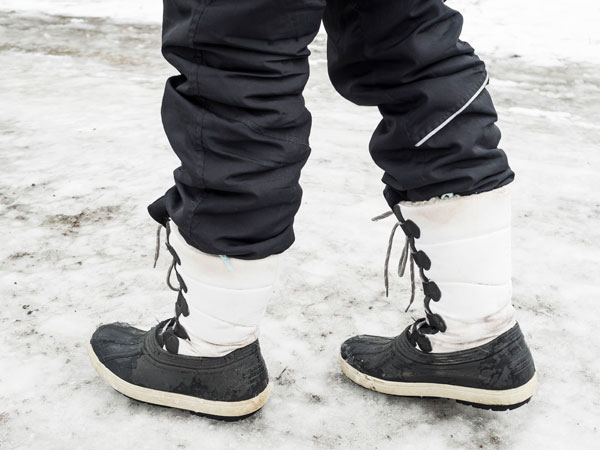According to a recent study by VTT, pedestrian slip-and-fall accidents occur frequently during winter causing substantial suffering and societal costs in Finland. Icy walking conditions, insufficient winter maintenance and inappropriate shoes often contribute to falls. Moreover, the consequences of falls are not experienced equally across population groups.
Walking is a favourable mode of travel due to its positive effects for health and the environment. However, the decision to travel on foot is influenced by safety concerns. Winter slip-and-fall accidents, which refer to falls leading to injury occurring as a consequence of slipping, represent a significant safety issue for pedestrians in Finland. The Pedestrian slip-and-fall accidents and their prevention: an equality perspective study estimated the frequency of slip-and-fall accidents and examined their prevention efforts, such as the effect of pedestrian weather-warning services and the role of winter maintenance, in Finland. The study was commissioned by the Ministry of Transport and Communications, the Finnish Meteorological Institute, the Finnish Transport and Communications Agency and the Finnish Transport Infrastructure Agency.

The frequency of slip-and-fall accidents
According to estimates in the study, roughly 125,000 pedestrian falls resulting in injury occur annually in Finland. Approximately 75,000 (60%) of these are winter slip-and-fall accidents, leading to costs worth approximately 1.3 – 1.4 billion euros. Women account for a greater proportion of those who have experienced a slip-and-fall accident than men, and elderly women are particularly likely to be seriously injured. The risk of injury when walking is considerably higher than that of driving a passenger car, using public transport or cycling when slip-and-fall accidents occurring in traffic environments are considered in risk calculations. Furthermore, in a public survey (n = 1215) conducted as part of the study, approximately a third of respondents had fallen due to slipping during the winter of 2020 – 2021. The youngest respondents (17–32-year-olds) had experienced the most falls, but the falls of those aged over 50 resulted in injury more frequently.
Although the frequency of winter slip-and-fall accidents has been known since studies conducted around the turn of the millennium, their frequency has not decreased. This is partially because slip-and-fall accidents are not considered traffic accidents in Finland and thus receive little attention in traffic safety work. Despite this, such falls frequently occur in traffic environments and can lead to serious injury and even death.
The frequency and severity of slip-and-fall accidents will likely grow in the future due to the aging population and increasingly frequent slippery walking conditions caused by climate change. A greater accident risk could also reduce the popularity of walking, potentially resulting in decreased physical activity. The increasingly sedentary lifestyles of Finns also represents a serious issue, leading to annual costs of approximately 3.2 – 7.5 billion euros (Vasankari et al. 2018). The prevention of slip-and-fall accidents could therefore encourage walking and help to counter this trend.
Prevention of slip-and-fall accidents
Winter maintenance measures, such as snow clearance and antiskid treatments, play a substantial role in the prevention of winter slip-and-fall accidents. Survey respondents generally regarded the quality of winter maintenance neutrally, but considered it important. Women over the age of 61 considered winter maintenance most important, and 17 – 32-year-old men considered it least important. The greater injury risk of the elderly may relate to the difference in views.
Pedestrians may also reduce the risk of slip-and-falls with their own behaviour, for example by wearing studded shoes or by choosing a safer route, and various pedestrian weather-warning services can help make such decisions. Although most survey respondents were unaware of such services, the majority of those who had used them reported modifying their behaviour, for example shoe choice, as a result. Therefore, pedestrian weather-warning services could reduce slip-and-fall accidents if their use was more widespread. Users of the services are mostly elderly, which is desirable due to their high risk of injury, but young people could also benefit from their use as they experience slip-and-falls frequently.
In general, the results of the study suggest that winter slip-and-falls are frequent, and they incur substantial annual costs to society. Young people fall due to slipping most frequently, but the elderly experience consequences that are more serious. The study recommends that slip-and-fall accidents occurring in traffic environments should be classified as traffic accidents and be better considered in traffic safety efforts.
References
Vasankari, T., Kolu, P., Kari, J., Pehkonen, J., Havas, E., Tammelin, T., Jalava, J., Koski, H., Pihlainen, K., Kyröläinen, H., Santtila, M., Sievänen, H., Raitanen, J., & Tokola, K. (2018). Costs of physical activity are increasing – the societal costs of physical inactivity and poor physical fitness. (31/2018; Valtioneuvoston selvitys- ja tutkimustoiminnan julkaisusarja). Valtioneuvosto. (In Finnish, with and abstract in English)
Malin, F., Mesimäki, J. & Penttinen, M. (2022). Pedestrian slip-and-fall accidents and their prevention: an equality perspective. (2022:2 Liikenne- ja viestintäministeriön julkaisuja). (In Finnish, with an abstract in English.)
Contact:

Johannes Mesimäki
johannes.mesimaki@vtt.fi
VTT Technical Research Centre of Finland Ltd., Finland






Follow us: